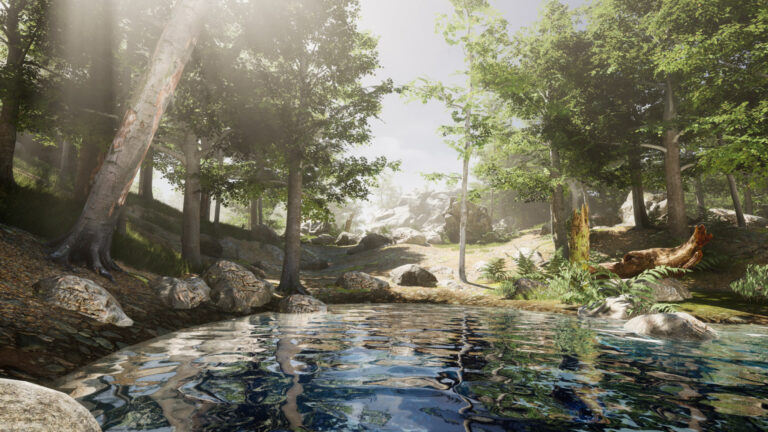 With the launch of Unreal Engine 5, NVIDIA announces support with key RTX technologies for developers to propel their games and experiences to the next level.
With the launch of Unreal Engine 5, NVIDIA announces support with key RTX technologies for developers to propel their games and experiences to the next level.
Unreal Engine is an open and advanced real-time 3D creation platform. Evolving from its state-of-the-art use in game engines into a multitude of industries, creators can deliver cutting-edge content, interactive experiences, and immersive virtual worlds. NVIDIA strives to simplify adoption of our technologies for developers to get hands on with leading-edge RTX technologies.
NVIDIA is supporting the launch of Unreal Engine 5 with key RTX technologies.Tens of thousands of developers leverage NVIDIA technologies and Unreal Engine to propel their games and experiences to the next level. You can get started building applications today.
We’ve created a series of introductory videos for NVIDIA technologies in UE5 including:
- Deep Learning Super Sampling (DLSS)
- RTX Global Illumination (RTXGI)
- NVIDIA Reflex
- NVIDIA Omniverse Connector for UE5
The video below provides an overview for implementing ray tracing in Unreal Engine 5.
Deep Learning Super Sampling
NVIDIA Deep Learning Super Sampling (DLSS) is a plug-in that uses deep learning algorithms to upscale or “super sample” an image, and helps during GPU heavy workloads like ray tracing. NVIDIA DLSS takes a lower resolution image and increases its resolution.
Core benefits include uncompromised quality with higher performance. DLSS uses advanced AI rendering to produce image quality comparable to native resolution, and in some cases even better quality, while only conventionally rendering a fraction of the pixels. A new temporal feedback technique gives incredibly sharp image details and improved stability from frame to frame.
With DLSS, developers can choose among several image quality modes from Quality to Ultra Performance. Balancing quality and performance is done by controlling the game’s internal rendering resolution.
Additional benefits include:
- NVIDIA Image Sharpening with a spatial upscaler and sharpening algorithm for non-RTX GPUs for cross-platform support.
- Deep Learning Anti-Aliasing mode or DLAA. This AI based anti-aliasing mode is for users with spare GPU headroom and looking for higher levels of image quality.
Get started with DLSS
To get started head to the DLSS download page, scroll down to the “Download UE Plugin” section, accept the terms of agreement, and launch the UE5 download link. Then you’re all set!
For a more visual walkthrough on how to install and implement DLSS view the video below.
RTX Global Illumination
NVIDIA RTX Global Illumination (RTXGI) is a fast, high quality, and scalable real-time global illumination solution. It uses ray tracing to provide infinite bounce in indirect lighting, without the need to bake lighting or create multiple light setups for scenes.
You can customize RTXGI to your needs on any DXR-enabled GPU, including the GeForce RTX 30 series, RTX 20 series, GTX 1660 series, and GTX 10 series. RTXGI’s scalable design gives you the control to decide when and where you want to crank up performance or max out image quality.
RTXGI is a plugin for UE5, however if you want more advanced features like indirect lighting in reflections and translucency support you can download the NVRTX branch.
Get started with RTXGI
To get started head to the download page and scroll down to the “Download UE Plugin” section, click the terms of agreement to start the UE5 download link, and you’re set.
View how to install and implement RTXGI with the video below.
NVIDIA Reflex
The NVIDIA Reflex plug-in reduces system latency, which is key for any title where a responsive experience is required. With native support in Unreal Engine 5, simply navigate to the plug-ins folder in UE5, search for NVIDIA Reflex, and enable.
Key features include:
- Low Latency Mode for reducing latency.
- Reflex Stats and Latency Markers. With Reflex Stats, gamers can get per-frame PC Latency without any special hardware. This metric is ideal for tweaking game, OS, and GPU settings.
- Automatic Configuration and Flash Indicator for automatic configuration of the Reflex Analyzer. The Reflex Latency Analyzer detects clicks coming from your mouse and measures the time it takes for the resulting pixels (such as a gun muzzle flash) to change on screen. The results are displayed through GeForce Experience.
Review the video walkthrough below for information on installing and implementing NVIDIA Reflex.
NVIDIA Omniverse Connector for Unreal Engine 5 preview
NVIDIA Omniverse is a 3D design collaboration and virtual world simulation platform for creators to connect and enhance 3D workflows. Developers can also easily build advanced 3D tools and expand their ecosystem reach.
At GTC 2022, NVIDIA introduced an updated Omniverse Connector for Unreal Engine including the ability to export the source geometry of Nanite meshes from Unreal Engine 5.
Review the Omniverse Connect documentation for information on installing and using Unreal Engine Omniverse Connector 104.1. For more information on Unreal Engine and NVIDIA technologies, visit our Unreal Engine developer page.
*Disclaimer: All versions of these plug-ins have been tested on UE 5.0 Preview 2, and may not be compatible in the full release of Unreal Engine 5.0.
